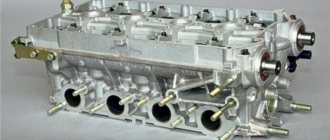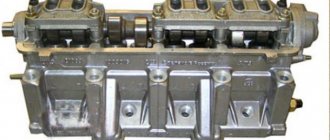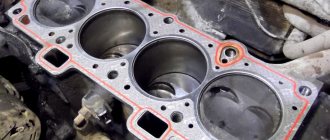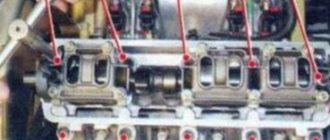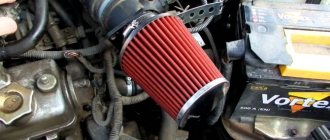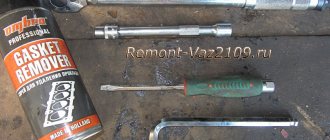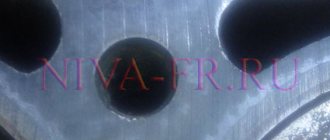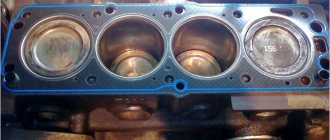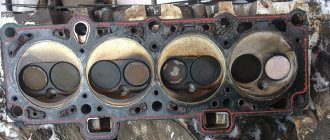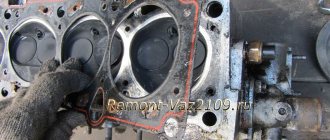What is the function of the cylinder head gasket?
The cylinder head gasket is located between the cylinder head and the cylinders and performs several functions:
- seals the place where the head adheres to the cylinder block;
- prevents oil from leaking and coolant from entering the cylinders;
- Restrains internal pressure and heat.
Thus, it separates three systems: gas distribution, cooling and lubrication. Experiencing heavy loads, it wears out quickly.
Gasket with traces of breakdowns
The following are signs that may indicate the need for replacement:
- insufficient pressure in one or more cylinders;
- foaming of the coolant, a drop in its level in the absence of an external leak, occurs due to gases entering the cooling system;
- emulsion on the oil dipstick, an increase in the oil level in the pan, the reason for this is the presence of antifreeze in the lubrication system;
- the appearance of oil stains on the surface of the coolant and the radiator neck indicates a broken gasket in the area of the oil channel;
- white smoke in the exhaust gases, while the coolant level drops;
- squeezing out the coolant fluid from the expansion tank in the form of foam indicates a violation of the tightness of one of the cylinders;
- The coolant level drops and the engine boils.
The video describes the signs of gasket burnout.
Damage to the gasket may be caused by:
- low-quality consumables;
- overheating of the power unit;
- improper tightening of cylinder head bolts;
- insufficient coolant level;
- Incorrect installation of the cylinder head.
When should you change?
Note that replacing the cylinder head gasket on a VAZ 2101-2107 is rarely done with your own hands. The manufacturer does not regulate the period for its replacement, since the part is installed for its entire service life. However, there are times when it burns out.
How to determine this malfunction? The first sign is engine overheating. The second is a leak at the junction of the block and the head. Both antifreeze and oil can escape from here. Also, these two fluids are mixed in the expansion tank. When the engine is running, there are small gas bubbles in the engine. All these signs indicate that the car needs to replace the head gasket. VAZ "Classic" is a simple car to use. Therefore, you can do this procedure yourself.
Installation
So, before us is the opened head of the block. All we have to do is remove the old gasket and install a new one in its place. It is important to thoroughly clean the contact surface. If this is not done, oil will leak through small channels into the adjacent chamber and mix with antifreeze. Experts recommend using a special spray.
It’s called “to remove gaskets.” Its cost is about 400 rubles. A volume of 300 ml is enough for several doses. Instructions for use are quite simple. It is necessary to apply the spray to the surface of the block and after ten minutes, remove the remaining element with a clean piece of rag.
The new gasket already has red silicone sealant on it. All we have to do is install it in its rightful place. Using two guides, we center the element in the block. Now all that remains is to assemble the engine.
Need for replacement
There are few reasons for replacement and some of them require immediate intervention, while others not so much, that is, the vehicle can be used, albeit in a gentle manner.
Reasons for replacement:
- Damage to the gasket in the area of the cooling system channel and the drainage channel of the lubrication system. When this happens, the coolant ends up in the oil pan and mixes with the lubricant. The result is a mixture with a brownish tint. This can be detected by checking the lubricant level in the power unit on the dipstick. This malfunction is also indicated by a decrease in the coolant level in the radiator. If you do not intervene in time, the consequences can be catastrophic, including the destruction of the power unit.
- Damage to the gasket in the area of the cooling system channel and cylinder. This may occur due to a poor quality gasket or an incorrectly installed head.
- Burnout in the cylinder area. This malfunction is detected and diagnosed by a decrease in compression in the cylinders and unstable engine operation. Burnout between cylinders
- Destruction of the gasket. If coolant begins to leak through the gasket and all efforts to tighten the cylinder head do not bring any results, then an urgent replacement is necessary.
Disassembly
So, where does the replacement of the cylinder head gasket begin on a VAZ-2107 car? First, remove the air filter with a round metal housing (shown in the photo below).
Next, unscrew and take out the carburetor. After this, they begin to dismantle other attachments. This is the ignition distributor and high-voltage wires. After this, the coolant is drained from the engine. It is required to prepare a clean container with a volume of at least 7 liters.
Also check out
- When disassembling the valve mechanism, it is necessary to place a wooden block under the valve plate.
Assemble and install the cylinder head in the reverse order.
Recommendations :
- Valve stems with engine oil. The same applies to guide bushings.
- Before installation, remove dirt, oil, and remnants of the old gasket from the surface of the cylinder block.
- The cylinder head gasket should be replaced using two special centering bushings.
- Install the mounting screws; the diagram below shows 4 steps on how to tighten them.
- The first tightening torque of the screws is 20 N.m (2 kgf.m);
- The second - with a moment of 69.4–85.7 N.m (7.1–8.7 kgf.m);
- The third - with an extension of 90°;
- The fourth is to turn the screws 90°.
Drain antifreeze correctly
On a VAZ-2107 car, replacing the cylinder head gasket is relatively quick. However, most of the operation will be draining the old antifreeze. The fact is that the “classic” does not have the familiar drain tap. There is a “traffic jam” here. How to perform this procedure correctly? So, we need a container and a meter of rubber hose with a diameter of at least 1 centimeter. We bring one end of it to the drain plug. With the other side, quickly press the hose against the hole. So the antifreeze will pour into our container. You need to be careful not to spill antifreeze on your hands.
What's next?
How to further replace the cylinder head gasket of a VAZ-2107? The next step is to remove the valve cover. It is secured with 8 bolts. It is important not to lose the pressure washers - they will be useful to us during assembly. The next step requires removing the timing element, namely the chain drive and gear. To do this, loosen the tensioner and use a wrench to release the locknut. The chain should now loosen. Now let's disassemble the gear.
We recommend: DIY repair and maintenance of Hyundai Solaris It is attached to the camshaft on a lock washer. Using a screwdriver and hammer, bend the stopper and unscrew the element outward. By the way, the chain does not have to be completely removed. The main thing is that it does not fall down. To do this, it is tied with a handy tool (for example, wire).
How to replace the cylinder head gasket next? The VAZ-2107 continues to stand still, and we move on to dismantling the camshaft. To do this, unscrew the 9 mounting bolts. Then we disconnect the exhaust pipe that goes to the exhaust manifold. It is installed on 4 brass nuts. If your pipe is screwed onto ordinary steel pipes, there is a risk of tearing off the pin. Be extremely careful. If there is rust or dirty deposits, use universal lubricant VD-40.
Step by step guide
VAZ 2107 cylinder head in the engine compartment
Many problems can be solved after tightening the bolts, but if this does not help, then a major overhaul of this unit may be necessary, which involves removing not only the cylinder head, but also other parts of the block. Some parts may need to be replaced, such as gaskets, valve stem seals and valve guides.
Tools
To work we will need the following tools:
- a set of keys;
- micrometer;micrometer
- flushing liquid;
- pliers;
- hammer;
- mandrels for removing and installing valves and caps;
- torque wrench;torque wrench
- tiles (preferably the spiral is closed);
- desiccant.Valve desiccant
Before starting repair work on the cylinder head, it must first be removed and cleaned of dirt.
Stages
Preparatory work and head removal
- The first step is to drain the coolant from the engine.
- We remove the carburetor.
- Having disconnected the pipes and hoses, remove the air barrier. Disconnect the hoses and pipes
- Remove the head cover.
- We align the marks on the crankshaft pulley with the mark on the camshaft drive and the marks on the camshaft pulley with the mark on its body as shown in the photo. Aligning the marks
- By disconnecting the camshaft lock washer, loosen the chain tension.
- Having torn off the bolt, remove the sprocket.
- Unscrew the fastenings.
- We remove the camshaft with the housing. Camshaft
- Having previously made marks using a marker, remove the rockers. Removing the rockers
- Disconnect the wires.
- We remove the pipe and unscrew the bolts securing the cylinder head to the block.
- We remove the head.
- We inspect its condition and clean it of dirt. Inspection of the condition of the head
This video shows the process of removing the cylinder head.
Checking status
Now it's time to dry out the valves. This is done with a special device. If chips, cracks, and rust are not visible, we conduct a further inspection. We evaluate the condition of the saddles, the repair of which is recommended every two hundred thousand kilometers.
Changing guide bushings
We inspect the guide bushings; if they are in unsatisfactory condition, they must be replaced.
A special tool is used to remove them. If you don’t have this on hand, you can get by with pliers and a clamp. After removing the bushings, we measure their diameter. We buy similar ones, the size of which is 0.05-0.07 millimeters larger than the ones being replaced.
The guides are pressed in using a mandrel, an electric stove, a hammer and lubricant.
- We place the head on a stand at the edges.
- We place the electrical device under the place of work.
- We wait until the metal heats up to about one hundred degrees (so that it expands).
- Now you need to properly lubricate the bushing with grease.
- Having removed it from the holders, we drive in new guides.
- When all eight are replaced, we wait for the cylinder head to cool down.
- The valves should not dangle and move freely, there should not be any jamming.
Checking the tightness of the head
Leak test
To ensure a tight fit of the valves to the seats, you must do the following. Using lapping paste, lubricate the valve and insert it into the head. There are several techniques for rotating it, here are some of them:
- using a hose tightly placed on the part;
- using a device very similar to a corkscrew.
The main sign of good valve lapping will be a specific matte surface of the seat in the place where it contacts the part.
The tightness of the head can be checked by pouring kerosene into the collectors; you can also use gasoline. If done correctly, there should be no leaks for the first five to seven minutes.
Attention! All engine parts must be washed with a special solution, this will ensure long-term and uninterrupted operation of the power plant for a long time.
When assembling the head, be sure to pay attention to the correct tightening of the bolts. It must be carried out strictly according to the scheme. In case of incorrect broaching, distortions may appear and, as a result, all your previous work will be crossed out. If you have any questions, watch the video.
You are repairing the cylinder head on your car
Survey
- On one's own
- At the service station
- No problems yet
Loading …
What to consider when choosing a new product
In order for the gasket to perform its functions, it must be resistant to elevated temperatures and have the ability to compress. These properties depend on the material of manufacture. There are several options for making gaskets: from asbestos, paronite, metal and their combinations.
Combined options, layers of which are made of different materials, combine several properties. Gaskets made of asbestos and metal alloys have increased resistance to high temperatures, but do not strengthen the seal between the head and the cylinder block. Products made of paronite and rubber provide high-quality sealing, but their limit for high temperatures is lower. When choosing a gasket, preference should be given to products of a combined type.
In order not to make a mistake when choosing a seal, it is necessary to take into account the characteristics of the power unit that is installed on the car. The VAZ 2107 can be equipped with one of three types of engines. They differ in cylinder diameter. The power unit 2103 has a diameter of 76 mm, while the 2105 and 2106 have a diameter of 79 mm. If you install a gasket of the wrong diameter, the edges of the seal will be damaged. Naturally, the seal will be broken.
When is it necessary to replace the cylinder head seal?
When a gasket burns out, the damage is significant: integrity is lost, the part loses its shape. In the event of a breakdown, the damage is minor, sometimes even invisible to the naked eye.
The gasket becomes unusable for the following reasons:
- overheat;
- During installation, fasteners are tightened with a deviation from the tightening torque standards;
- poor quality refrigerant;
- engine malfunctions;
- defective, low-quality product.
The power unit overheats due to malfunctions of the cooling system elements: radiator, fan, etc. To burn out the gasket, it is enough to drive literally 500 meters. When installing the cylinder head seal, it is important to observe the order of tightening the fasteners and the torque to which they are tightened. If these rules are violated, the seal will be deformed and will subsequently be broken. Poor quality coolant can cause corrosion, causing damage to the seal material and even the cylinder head.
A damaged cylinder head gasket can be identified by the following signs:
- interruptions in the operation of the power unit;
- leaks of working fluids from under the cylinder head;
- rapid heating and overheating of the motor;
- traces of coolant in lubricants;
- steam in exhaust gases;
- condensation on spark plugs;
- increased pressure in the cooling system, smoke appears in the expansion tank.
Symptoms vary depending on where the gasket is damaged. If the edges of the cylinder bores are damaged, the engine may overheat and the pressure in the cooling system may increase.
If the coolant gets into the combustion chambers, the engine will start to stall, since it will be diluted with refrigerant in the fuel assembly and will not be able to burn completely. White smoke with a specific odor will come out of the exhaust pipe.
If there is damage on the edge of the seal, leaks of working fluids may occur at the point of contact between the cylinder block and the head.
Signs of a burned out cylinder head gasket.
If signs of seal burnout appear, you need to take a comprehensive approach to diagnosis. Before you start replacing the seal, you need to make sure that this is the reason. To do this, you need to perform the following series of actions:
- Having discovered fluid leaks on the cylinder block, you need to make sure that it is flowing exactly from under the head.
- We start the engine and analyze the color and smell of the exhaust. If they look like white smoke or smell like antifreeze, turn off the engine and carefully unscrew the cap from the expansion tank. The presence of exhaust gases in the cooling system is indicated by the smell of burnt fuel.
- We start the engine without a cap on the expansion tank; there should be no traces of oil or gas bubbles inside it.
- We turn off the engine and let it cool. We take out the dipstick to measure the oil level and look at its color. If its level has risen too much for no particular reason or there are traces of white-brown liquid, this indicates a mixture of oil and refrigerant.
- Let the power unit run for 5 minutes and turn it off. We take out the spark plugs and inspect the electrodes. If they are wet, then there is a high probability that coolant has entered the cylinders.
Removing the cylinder head
Sequencing:
- Remove the battery. This will provide convenient access to the GBS head and protect against short circuits.
- Remove the air filter.
- Remove the carburetor on the carburetor version of the engine.
- Remove the ignition wires and distributor (if equipped).
- Drain the coolant from the cylinder head by unscrewing the plug. Before draining, you need to wait until the engine has cooled down.
- Loosen the clamps and disconnect the rubber pipes of the cooling system going to the cylinder head.
- Remove the valve cover by unscrewing the 8 nuts and removing them along with the shaped pressure washers.
- Loosen the chain tensioner by unscrewing the fixing nut. For convenience, you can completely dismantle it.
- Using a screwdriver and hammer, bend the edges of the lock washer on the camshaft gear mounting bolt and unscrew the bolt. Remove the gear. Tie the chain removed from the gear with wire so that it does not fall into the engine sump.
- Unscrew the camshaft mounting nuts (10 pieces) and remove it.
- Unscrew the brass nuts securing the exhaust pipe to the exhaust manifold and remove it along with the gasket.
- Using a powerful wrench, unscrew the 10 bolts that tighten the cylinder head and the eleventh bolt installed on the head casting. Remove the head. It is quite heavy, so in order not to scratch the car, it is better to remove it from the block together.
Video about replacing the cylinder head on a VAZ
Video “Replacing a burnt gasket on classic Lada models”
In this video, an experienced master will clearly show and explain in detail how to correctly change the cylinder head gasket on classic Lada models. On a VAZ 2107 with an injection and carburetor engine, all work is carried out according to the same scheme.
Replacing the cylinder head gasket of a VAZ 2107 on an injection engine is carried out in the event of its breakdown when coolant begins to flow into the cylinders. To carry out repairs, it is necessary to drain the coolant from the unit by unscrewing the drain plug in its lower part.
The order of dismantling work is as follows:
- After draining the coolant, remove the battery from the car.
- Disconnect the power wire from the temperature indicator sensor. The sensor is screwed into the block head.
- We remove the exhaust pipe. To do this, unscrew the nuts securing it to the intake manifold studs.
- Now you need to remove the upper housing assembly with the camshaft. Before removing it, it is necessary to set the piston of the fourth cylinder to the TDC position. We remove the upper housing, and then tie the camshaft drive chain with wire so that it does not fall through.
- Remove the starter heat shield by unscrewing the nut securing it.
- We disconnect the ground wire from the intake manifold stud, and then remove all the pads with wires from all sensors. Disconnect the wiring harness from the idle speed sensor and the wiring harness from the fuel injectors.
- Disconnect the throttle valve drive cable and remove it. Unscrew the nuts securing the bracket and move it to the side. Disconnect the coolant drain hose from the throttle body.
- At the next repair step, we need to remove the thermostat bypass pipe and the radiator inlet pipe. Next, remove the car interior heating hose from the pipe.
- Disconnect the fuel supply pipes from the fuel rail.
- Remove the vacuum hose from the receiver pipe.
Now that all the attachments have been removed from the cylinder head, you can unscrew the bolts securing it to the block. To do this, unscrew ten internal bolts with a socket wrench and one outer bolt with a thirteen key. After unscrewing the bolts, you can remove the cylinder head and gasket.
Replace the gasket with a new one and install it back on the cylinder block, having first passed the camshaft drive chain through the opening. Before installing the block head, measure the length of the bolts using a caliper; their length should not exceed 11.5 cm; if exceeded, replace the bolts with new ones. At this point, the repair work on removing and replacing the cylinder head gasket of the VAZ 2107 is completed.
Cases when it is necessary to replace cylinder head gaskets
Replacing the cylinder head gasket of the VAZ-2107 is mandatory in a number of cases:
- If there is damage near the combustion chambers, engine overheating leads to this unpleasant situation. When the cooling system malfunctions, and the driver prefers not to pay attention to the malfunction and puts off repairs, the condition of the cylinder block and its head leaves much to be desired.
- A leak of antifreeze or coolant is noticed - a breakdown is often accompanied by incorrect operation of the ventilation device, thermostat, or a banal leak of substance from the hoses.
- There is an engine oil leak. If traces of oil leakage are noticed on the outside, it means the gasket is not fitting well. Tighten the head bolts, if this does not help, then you will have to replace the cylinder head gasket yourself.
Finding the cause of gasket damage
After the VAZ 2107 cylinder head is removed, you should inspect the gasket for damage and try to determine the cause. If the cause is not identified and eliminated, it is possible that the new gasket will soon also burn out.
Burnout of the gasket between the cylinders occurs due to engine overheating, constant detonation of low-quality fuel, or cylinder head deformation due to temperature effects or improper tightening. In this case, you will have to grind or change the head before assembly.
The gasket can be destroyed by rust. This happens if water is used in the cooling system instead of antifreeze. The VAZ engine is not designed for cooling with water, so after installing the gasket and cylinder head, it is necessary to flush the system and fill it with antifreeze.
Another reason for the destruction of the gasket is its poor quality. In this case, it is enough to simply replace the gasket with a good one.
Assembly
Pay attention to such a moment as tightening the cylinder head. A lot will depend on this operation. If you do not apply force, the gasket will burn out and the engine may boil. Therefore, experts recommend using a torque wrench (see figure below).
The bolts are tightened according to a special pattern - from the middle to the edges. The first tightening force is 4.1 kgf per meter. The second one is 11.45. This applies to ten large bolts. What about the little one, 11th? Here the tightening rate is 3.8 kgf/m. If your key is designed for Nm, the first tightening requires a value of 40 units. The second is produced with a force from 95 to 117 Nm. After replacing the cylinder head gasket on a VAZ-2107 car, you need to install the camshaft and split gear back. It is important to adjust the timing drive. Yes, on an 8-valve engine the pistons will not come into contact with the “plates”. However, there will be significant misfires (to the point where the engine simply won’t start). At this point, the replacement of the VAZ-2107 cylinder head gasket has been successfully completed. You can make the first start and check the operation of the motor. Don't forget to pour antifreeze into the system.
How to remove the snail on a VAZ 2107 injector
Cleaning and replacing injectors
Injector purpose
Installing an injector in the VAZ 2107 made it possible to significantly improve engine performance. Changing the type of fuel system increases the amount of energy that is produced during the combustion of gasoline. Compared to a carburetor engine, a fuel injection system is more efficient in the initial stages, but over time its performance decreases. What does this depend on?
The injector plays the role of the final element in the fuel system of the car. The air mixture, together with a cloud of atomized gasoline, creates a huge amount of energy. Over time, this atomization may become less effective, the fuel jets will become weaker, and all due to low-quality gasoline.
The main cause of injector failure is poor fuel. Car fuel consists of many chemical components; in addition, various impurities are added to it, which should improve the overall performance of the engine. This factor cannot be ignored, since such gasoline leaves sediment on the walls of the fuel system. The thinnest channels are in the injectors, and it is these devices that suffer first. During operation, deposits from fuel only accumulate. What needs to be done to stop this?
Removing and washing injectors
In this article I will describe the process of removing injectors on a VAZ-2107 car. The owner complained about tripping and rough operation of the engine when running on gasoline. After diagnostics, it was discovered that the injectors were clogged. The car is additionally equipped with 2nd generation gas equipment, the so-called “cracker”. In this regard, the view in the photographs may differ slightly from yours (presence of a firecracker, injector emulator, etc.). In Fig. Figure 1 shows the appearance of the engine compartment of the vehicle being serviced.
Let's get started. We unscrew the clamps securing the air pipe using a Phillips screwdriver or a 7 mm socket.
Remove the throttle cable clamp using a “flat” screwdriver, carefully prying it up.
Open the throttle valve and remove the throttle cable.
We unscrew the fastening of the throttle cable using a 10 mm “head”.
We unscrew the fuel lines with two 17 mm open-end wrenches. We unscrew the fastening of the tubes with a Phillips screwdriver.
Remove the vacuum hose from the fuel pressure regulator.
Remove the brake booster hose by unscrewing the clamp with a flat-head screwdriver.
We unscrew the two nuts securing the throttle assembly using a 13 mm “head”. We remove it, holding the washers on the studs, and move it to the side.
Unscrew the intake manifold mounting nuts using a 13 mm “head”. We remove the washers.
Removing the fuel line fasteners
Remove the intake manifold and put it aside.
Unscrew the fuel rail mounting bolts with a 5 mm hexagon.
Remove the injector harness connector by slightly pulling the lock towards you.
We take out the ramp along with the injectors. If the injectors fit tightly on the rings, then you can carefully pry off the ramp with a pry bar.
Remove the injector harness by pressing the latches on the connectors.
Remove the injector clamps by sliding them to the side along the fuel rail.
We take out the injectors. To do this, we stagger and pull them towards ourselves.
We see rust both in the injectors themselves and in the fuel rail. Somewhere a man was filled with gasoline and water.
If you are installing new injectors, you can skip the next few steps. Otherwise, wash the dirt on the injectors with a brush in gasoline. We wash them in an ultrasonic bath. We check injectors for performance and leakage in a test bench.
We install new sealing rings on the injectors, having first removed the old ones, prying them off with a screwdriver.
It is better to put a brown rubber ring on the bottom of the nozzle; it is more heat-resistant and will last much longer. If the condition of the old rings is good, then it is better to leave them, since the quality of the new ones leaves much to be desired.
If necessary, replace the injectors with new ones. You need to buy according to the number on the nozzle. In our case, Bosh 0 280 158 502.
We wash the fuel rail with gasoline or Abro carburetor cleaner and blow it with compressed air.
Before installing the injectors into the fuel rail, the rings on the injectors must be lubricated with something, for example WD-40. This helps to avoid damaging the rings during installation.
We install the injector clamps in place. Please note that the fourth injector is installed with the connector in the opposite direction.
We put on the injector harness. We install the nozzles in place, also lubricating the rings with WD-40.
Before disassembling, we noticed that the clapper and the throttle valve were very dirty.
Now is the time to wash the throttle assembly, idle air control (IAC) and gas firecracker.
Next, we collect everything in reverse order, but take into account some points. Don't forget to put the hose on the fuel pressure regulator.
We look at the condition of the throttle assembly gasket and, if necessary, replace it with a new one.
We install new sealing rings for the gas lines.
Be sure to change the fuel filter. For VAZ cars there are filters of the old (with “screws”) and new (with “snaps”) models. In our case, an old-style filter is installed.
To remove the fuel filter, first unscrew the fuel lines using a 17 mm open-end wrench, holding the filter housing with a 19 mm open-end wrench. Then unscrew the filter itself with a 10 mm head.
This is what came out of the filter in our case.
We install a new fuel filter and gas line O-rings. Do not forget to take into account the direction indicated by the arrow on the fuel filter housing.
We tighten the fuel lines without overdoing it and hold them, excluding cutting the fuel rings.
Let's check if we have any extra spare parts left ;). We start the engine and check for fuel leaks and air leaks.
We look at the result obtained and the smooth operation of the engine.
How to clean injectors
Methods for cleaning sprayers may vary; the use of one method or another depends on the level of contamination of the holes and the nature of the deposits. If you carry out preventive cleaning or remove light contamination, you can use special chemicals, the use of which does not involve removing the injectors.
If the injectors are in a neglected state and cleaning with additives does not make sense, then you will have to dismantle the injector and replace the injectors.
First cleaning method
For this method, you will need injector cleaner, carburetor cleaning fluid (spray), a spare O-ring and a pump with a pressure gauge. The first thing you need to do is remove all the nozzles, because if you decide to clean it, you need to do this with all the nozzles, and not just one. Find a suitable container and pour the injector cleaning fluid into it. Place all the injectors in a container and leave them there for a while to allow them to acidify. While the injectors are in the container, take the prepared carburetor spray and clean the idle air control with it. Now inspect the area around the injector nozzle; carbon deposits form there - coke, which in its consistency resembles resin. You will have to take some kind of metal object and tinker with this type of contamination. In order to carry out internal cleaning of the injectors, you need to prepare a power source (from 3 to 12V) and a foot-operated mechanical pump equipped with a pressure gauge.
Remove the tip from the hose and pour injection cleaner into the resulting hole. After this, put the end of the hose on the nozzle. Pump up the pump to 6 atmospheres and apply a voltage of 3V to the injector. If you do not hear the injector click, then you need to add voltage. You need to apply voltage periodically, while not forgetting to pump up the pump to six atmospheres. Clean all injectors in this manner.
Second way
For this method you need a carburetor cleaner spray and also a pump with a pressure gauge. We repeat all the operations indicated in the previous method, only change the injector cleaner to a carburetor cleaner. It is mandatory to carry out external cleaning to remove carbon deposits. To do this, take a clean cloth and apply the cleaner to it. Treat all fuel units with this cloth. Gradually, under the action of the cleaner, the coke will soften and be cleaned off without any problems. You can help yourself with a screwdriver or toothpick.
Both operations should take an average of two hours of your time, but you will save a lot and learn how to clean injectors.
Start of work
The very first step is to remove the air filter. Of course, on a carburetor engine it is somewhat easier to remove it. If you have an injector, you will have to tinker with its rubber fasteners. But the essence remains the same - it is necessary to disassemble the fuel system completely to get to the cylinder head. But we will look at the example of not an injection, but a carburetor seven. Still, there are many more classic cars with such a power system.
It is advisable to dismantle the carburetor, since if you remove the head along with it, you can accidentally damage it. On all classic series cars, the carburetor is removed in the same way. This procedure is quite simple, but it will take some time. Now you can unscrew the nut securing the distributor and remove the distributor along with the wires. Getting closer to the engine, all that’s left to do is drain the antifreeze from the system.
And then turn off all the pipes that you see. After this, it will be possible to dismantle the cylinder head cover. It is secured with nuts and shaped washers. Don't lose them during repairs. That's all, the preparation is complete, you can begin the most difficult part - dismantling and installing the cylinder head.
Which cylinder head gasket is the best?
The sealing gasket serves to strengthen the engine cooling channels and well preserves the oil channels in the cylinders that have the gas distribution function. Therefore, it is not worth saving on the cylinder head gasket. If the part is of poor quality, a breakthrough may occur between the cooling system channel and the drainage channels of the lubrication system. There is a breakthrough located at the junction of the cooling system channel and the cylinder.
By the way, the same thing happens when the cylinder head is loosely tightened, but in any case the gasket will have to be changed.
Automotive stores sell the following types of cylinder head gaskets intended for installation in the VAZ-2107:
- Asbestos - involves associated engine repairs. The advantages of the material are heat resistance, increased elasticity, and good elasticity characteristics.
- Non-asbestos products are also easy to use, and all thanks to minimal shrinkage and excellent restorative properties.
- Metal ones are considered the best among all other cylinder head seals. The point is that the pressure is distributed evenly throughout the block.
A video of how to replace the cylinder head gasket of a VAZ-2107 with your own hands can be seen below:
How to clean injectors on a VAZ 2107 injector - causes of breakdowns and diagnostics
On injection-type cars, devices called injectors are installed. They are a sprayer through which fuel is supplied to the working chamber of the cylinder. The injection duration and fuel quantity are controlled automatically, for which the ECU is responsible. As the vehicle operates, these devices become clogged. We will look in detail at the material on how to clean the injectors on a VAZ 2107.
Causes and symptoms of malfunctions of the seven injection nozzles
Injectors are one of the most important parts of the fuel injection system. If it fails, which happens extremely rarely, the operation of the engine is disrupted. Most often, fuel injectors become clogged, which occurs due to contact with aggressive media. An aggressive environment is not only the fuel, but also the burned fuel assemblies. Before cleaning the injectors on a VAZ 2107, you need to determine by the signs that diagnostics of these particular parts is required:
- At idle, unstable operation of the internal combustion engine is observed.
- When trying to move away, the engine stalls.
- Reduced power and agility.
- When moving, jerks and dips occur.
- Excessive amount of exhaust gases from the muffler.
- Increased fuel consumption.
- Extraneous sounds and noise are observed when the engine is running.
If these signs are detected, you will need to check the condition of the injectors. The reason for their clogging is low-quality gasoline, which causes deposits to form on the walls. If your car has a faulty or missing fuel filter, then the need to clean the fuel nozzles arises quite often.
After removal, you will need to check the devices, or rather their condition. How to check the injectors on the seven, we will figure it out in the next section. If diagnostics show that they are unsuitable for use, they will need to be replaced.
It is important! When purchasing, you need to know the article number of the device, which has the number 21110-1132010-82.
Device diagnostics
To make sure that the injectors need to be cleaned or replaced, you will need to first perform some diagnostic procedures:
- Testing performance by ear. The principle of testing is that you need to start the engine and listen to the work. The presence of a ringing sound indicates that the fuel nozzles need to be cleaned.
- The injector is checked with a multimeter. This method is more objective, as it allows you to obtain more accurate information. The principle of checking is that you need to disconnect the chip from the atomizer and connect the probes of the device to the contacts. The device is set to resistance measurement mode. If the resistance value fluctuates between 12-17 Ohms, then the device does not need to be cleaned.
- To make such a diagnosis, you will first need to remove the injectors from the car by disconnecting them from the fuel rail and cylinders. The test consists of installing the injectors on a special stand. The stand is used to pass fuel through nozzles under appropriate pressure. Based on the parameters of the resulting jet, the serviceability of the nozzles is assessed. If the fuel in the nozzles is sprayed unevenly, the device needs to be cleaned.
If, after diagnostics, it is determined on the injection seven that one or more injectors need cleaning, then it is necessary to resort to this procedure. Regardless of how many nozzles need cleaning, the procedure must be carried out for all four.
How to clean injectors with additives
If, during diagnostics using a multimeter, it was determined that one or more nozzles need cleaning, then the easiest way to do this is to use special chemicals. In this case, the injectors do not need to be removed from the car. However, this method is not appropriate in all cases. If the sprayers are in a neglected state, they will need to be removed and cleaned on a stand.
Washing of VAZ 2107 injectors is carried out on a special diagnostic stand. To carry out the procedure, you will need to remove all 4 sprayers from the car and install them on the stand. Special products are used as cleaning fluids. The disadvantage of this method is that its implementation will require an expensive stand. Such stands are available in car service centers, and the principle of washing nozzles is as follows:
- All 4 sprayers are secured to the stand.
- A cleaning liquid is poured into a special container; as a rule, it is a carburetor cleaner.
- The program starts, and the stand automatically cleans the injectors for a certain time.
If the option of using a stand is available to drivers only in car repair shops, then the use of special preparations allows cleaning to be carried out at home. To flush the fuel nozzles along with the fuel system, you will need to use special chemicals. They are recommended to be used every 20 thousand km. The principle of their use is that the pump is disconnected from the fuel line. A special cylinder is connected to the hose, from which liquid will be supplied under high pressure.
The engine starts, after which it continues to run at idle for half an hour. After the engine has been running for 30 minutes, you need to turn it off and wait half an hour. During this time, all deposits will soften. The engine starts again, but this time you need to increase the speed to maximum. This will allow the remaining slag and other deposits to be removed from the system.
Manual cleaning
If the cleaning method using a special liquid did not allow you to obtain a satisfactory result, and contacting a car service is not suitable for you, then there is another option. This option means that you can clean the VAZ 2107 injector nozzles yourself. To implement this method, you will need the following components: a special cleaner, a set of keys and screwdrivers, and a 5 ml syringe. The principle of manual cleaning of injectors on the seven is to implement the following actions:
- Loosen the clamps securing the air pipe and remove it.
- Remove the throttle cable clamp using a screwdriver, and then the cable itself along with the fastener.
- Remove the fuel lines along with the pipe fastenings.
- VUT hoses are dismantled.
- The fuel line brackets are removed along with the intake manifold.
- Remove the fuel rail mounting bolts.
- The fastening harness is loosened, after which you can dismantle the fuel rail along with the injectors.
The principle of manual cleaning is that you need to connect a bottle of cleaner with a nozzle through a syringe. After this, ensure that the nozzles are cleaned. This method cannot be called reliable, but it is quite effective in cleaning moderately dirty injectors. If you choose this method, it is recommended to implement it systematically.
In conclusion, we must summarize and note that cleaning fuel nozzles is one of the most important stages in repairing the fuel system on injection engines. After completing the work, the productivity of the injectors increases, which has a positive effect on increasing engine power.
